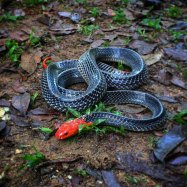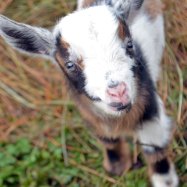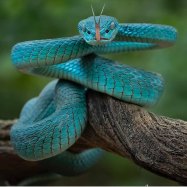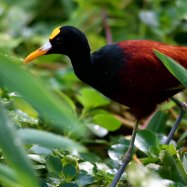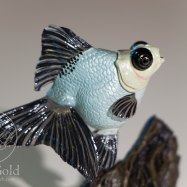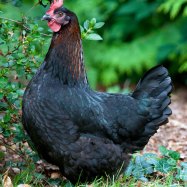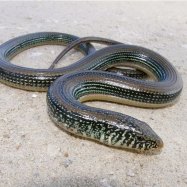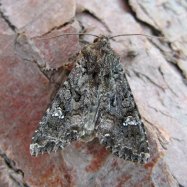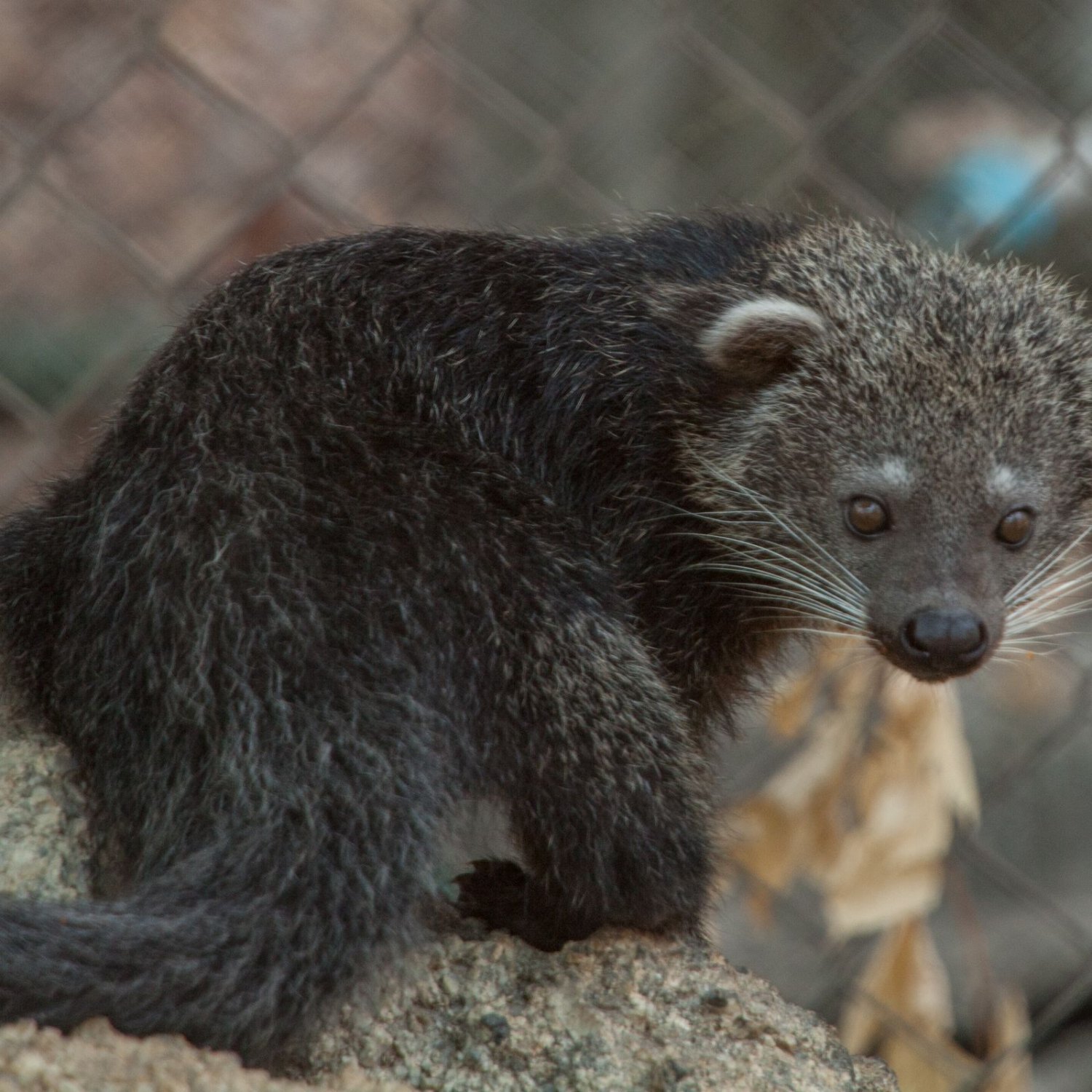
Binturong
2 - 3 feet
Binturongs, also known as bearcats, are unique carnivorous animals found in trees. With a length of 2-3 feet, they are part of the Viverridae family and have a long and muscular body shape. These fascinating creatures can often be seen hanging upside down from tree branches in search of their next meal.
Animal Details Summary:
Common Name: Binturong
Kingdom: Animalia
Habitat: Tropical rainforests
Binturong: The Tree-Loving Bearcat of Southeast Asia
The world is full of fascinating and unique creatures, but one animal that often goes unnoticed is the Binturong. Also known as the Asian Bearcat, this mammal belongs to the Viverridae family and is native to Southeast Asia, particularly the island of Borneo. With its distinctive appearance, ability to live high up in the trees, and interesting habits, the Binturong is a truly remarkable animal that deserves more attention. In this article, we will delve into the world of the Binturong and discover what makes it such a special and fascinating creature Binturong.A Closer Look at the Binturong's Taxonomy
Scientifically known as Arctictis binturong, the Binturong belongs to the Kingdom Animalia, which means it is a multicellular organism that can move and obtain its own food. Within this kingdom, it falls under the Phylum Chordata, meaning it has a spinal cord and a backbone. This puts the Binturong in the same category as many other well-known mammals such as dogs, cats, and humans.Moving further down the taxonomic hierarchy, the Binturong belongs to the Class Mammalia, indicating that it is a warm-blooded vertebrate with hair or fur and produces milk to feed its young. It is placed in the Order Carnivora, which refers to its dietary habits - the Binturong is an omnivore, meaning it eats both meat and plants. Finally, within the Carnivora order, the Binturong falls under the Viverridae family, which includes other small carnivorous mammals such as civets and genets.
A Habitat Among the Trees
One of the most distinct characteristics of the Binturong is its habitat. This mammal can be found dwelling in the dense tropical rainforests of Southeast Asia, particularly in countries like Malaysia, Indonesia, and Thailand. However, its primary home is the island of Borneo, where it can be found living in the trees Bonefish.The Binturong is an arboreal animal, meaning it spends most of its life in trees. Its long and muscular body, sharp claws, and prehensile tail are all adapted for life in the trees. It can easily move around on branches and jump from tree to tree, making it an impressive climber. In fact, it has been observed that the Binturong can even hang upside down from branches while eating, thanks to its strong tail.
An Omnivorous Diet
As mentioned earlier, the Binturong is an omnivore. This means its diet consists of both plant matter and meat. In the wild, it feeds on a variety of fruits, birds, rodents, insects, and small reptiles. Its sharp claws and powerful jaws allow it to catch and eat its prey effortlessly. Interestingly, this mammal's sense of smell is also highly developed, allowing it to track down small prey even in dense forests.When it comes to plant matter, the Binturong consumes a range of fruits, leaves, and flowers. It has been observed that it is particularly fond of figs, which are a major part of its diet. The Binturong is also known for its love of honey, often raiding beehives for this sweet treat.
Southeast Asia: The Binturong's Geographical Distribution and Origin
As mentioned before, the Binturong is native to Southeast Asia, specifically the island of Borneo. It can also be found in other countries in the region, including Thailand, Malaysia, Indonesia, and the Philippines. Within its range, this mammal can be found in the highlands, lowlands, and even up to 8,000 feet above sea level.The Binturong has been living in Southeast Asia for hundreds of thousands of years, making it a truly ancient species. Fossils of its ancestors have been found dating back to the Pleistocene era, which was over 2 million years ago. Today, it is considered an important and valuable part of the region's biodiversity.
The Distinctive Appearance of the Binturong
The Binturong is a visually striking animal, with a unique appearance that sets it apart from other mammals. It has dark brown or black fur, which is thick and coarse, helping it stay warm and protected in its forest habitat. Its muzzle and face are white, with dark lines running from its eyes to its ears. Its short, rounded ears are also quite distinct, as they have a tuft of white hair growing on their tips.One of the most interesting features of the Binturong is its tail. As mentioned earlier, this long, muscular tail is prehensile, which means it can grip and hold on to objects. This is incredibly useful when climbing and jumping from tree to tree, and it also helps the Binturong maintain its balance while hanging upside down. The tail also serves as a great balancing tool when the Binturong is on the ground, which is quite rare.
A Long and Muscular Body, Perfect for Tree-Life
The Binturong's body is also worth noting, as it is well-adapted for its arboreal lifestyle. It has a long, lean body that can measure anywhere from 2 to 3 feet in length. Its muscular build allows it to move swiftly and effortlessly through the trees. It is also a relatively light animal, with weights ranging from 20 to 55 pounds, depending on its age and gender.The Binturong in the Wild
In the wild, the Binturong is typically a solitary animal, only coming together with others during mating season or when raising young. It is a largely nocturnal creature, meaning it is most active at night, spending its days sleeping or resting in tree branches. Due to its somewhat elusive nature, there is still a lot to learn about the Binturong's behavior and habits in the wild.However, what we do know is that this animal plays an important role in its habitat. As an omnivore, it helps maintain balance in the ecosystem by preying on smaller animals and controlling plant growth through its consumption of fruits and leaves. It is also considered to be a keystone species, meaning it has a significant impact on its environment due to its wide range of dietary habits.
In Conclusion
The Binturong may not be as well-known as other animals, but it is without a doubt a fascinating and unique creature. From its distinctive appearance and tree-dwelling lifestyle to its omnivorous diet and ancient origins, there is much to admire and learn about this mammal. As we continue to explore and protect the forests of Southeast Asia, we can only hope that this elusive and remarkable animal will continue to thrive and contribute to the rich biodiversity of the region.

Binturong
Animal Details Binturong - Scientific Name: Arctictis binturong
- Category: Animals B
- Scientific Name: Arctictis binturong
- Common Name: Binturong
- Kingdom: Animalia
- Phylum: Chordata
- Class: Mammalia
- Order: Carnivora
- Family: Viverridae
- Habitat: Tropical rainforests
- Feeding Method: Omnivorous
- Geographical Distribution: Southeast Asia
- Country of Origin: Borneo
- Location: Trees
- Animal Coloration: Dark brown or black
- Body Shape: Long and muscular
- Length: 2 - 3 feet
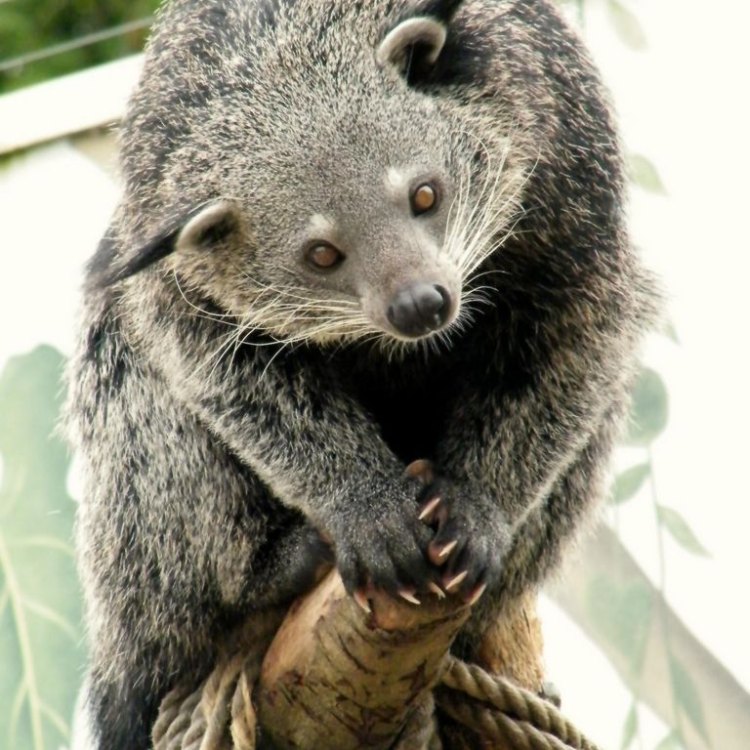
Binturong
- Adult Size: Up to 60 pounds
- Average Lifespan: 25 - 30 years
- Reproduction: Viviparous
- Reproductive Behavior: Solitary
- Sound or Call: Low-pitched growls and screams
- Migration Pattern: Non-migratory
- Social Groups: Solitary
- Behavior: Nocturnal and arboreal
- Threats: Habitat loss and poaching
- Conservation Status: Vulnerable
- Impact on Ecosystem: Seed dispersal
- Human Use: Hunted for meat and body parts
- Distinctive Features: Prehensile tail and scent glands
- Interesting Facts: Also known as the bearcat
- Predator: Tigers and large snakes
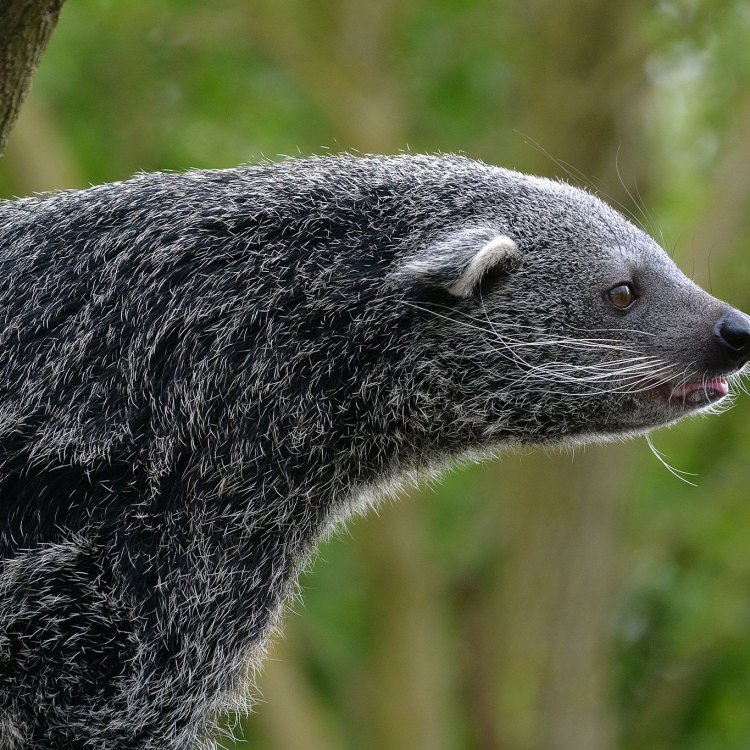
Arctictis binturong
The Mysterious Binturong: A Unique and Vulnerable Species
In the lush forests of Southeast Asia, a mysterious creature roams the treetops, hidden from the human eye. With its thick, dark fur and long, prehensile tail, the Binturong is a truly fascinating and unique species. Also known as the bearcat, this solitary and nocturnal creature has captured the curiosity of nature lovers and scientists alike.In this article, we will delve into the world of the Binturong, exploring its distinctive features, behaviors, and threats to its survival PeaceOfAnimals.Com. Join us on a journey to discover more about this elusive and vulnerable species.
Meet the Binturong
The Binturong, scientific name Arctictis binturong, is a mammal native to the dense forests of South and Southeast Asia, including Malaysia, Indonesia, and the Philippines. It belongs to the Viverridae family, which also includes mongooses and civets.The Binturong is a medium-sized animal, ranging from 2.5 to 3 feet in length and weighing up to 60 pounds. It has a stocky build, with short and sturdy legs, making it a proficient climber. Its thick, dark fur is mostly black or dark brown, with a lighter coloration on its face and underside. However, what sets the Binturong apart from other animals is its distinctive and unique features.
Powers of the Prehensile Tail
One of the most striking features of the Binturong is its long and prehensile tail Bass. This means that the end of its tail can grip and hold onto branches like a fifth limb, allowing the Binturong to hang upside down from trees and move with agility and precision.This feature is especially helpful for the Binturong, as it is an arboreal species, spending most of its life in trees. Its tail also acts as a counterbalance when climbing, allowing it to navigate through the dense canopy with ease. Unlike most animals with prehensile tails, the Binturong's tail has a bare, skin-like structure rather than fur, which aids in its gripping abilities.
Powerful Scent Glands
Another distinctive feature of the Binturong is its scent glands, located near its tail. These glands produce a strong, musky odor that can linger for weeks. This scent is used for communication and marking of territory.Interestingly, the Binturong's scent is similar to that of freshly popped buttered popcorn, earning it the nickname "popcorn bear." Despite its cute nickname, the Binturong's scent glands are used for defense against predators and attracting potential mates.
A Solitary and Nocturnal Life
The Binturong is a solitary animal and rarely interacts with other members of its species, except during the breeding season. It is mostly nocturnal, meaning it is most active at night. This behavior serves as protection against predators, as it can blend into the dark canopy and avoid being seen.Being mostly solitary also means that the Binturong has a large home range, with males having a territory of up to 12 square miles and females having a smaller territory of about 4 square miles. Its solitary and elusive nature makes studying the Binturong a challenging task for scientists.
The Reproductive Habits of the Binturong
The Binturong is a viviparous species, which means that it gives birth to live young instead of laying eggs. The gestation period can last anywhere from 91 to 92 days, with litters consisting of one to four cubs.After birth, the cubs are cared for solely by their mother. They are weaned at around three months old and will stay with their mother for up to two years, until they reach sexual maturity. During this time, they learn essential survival skills from their mother, such as hunting and avoiding predators.
A Vulnerable Species Threatened by Human Activities
Despite its unique features and behaviors, the Binturong is facing significant threats to its survival. The main threat comes from habitat loss due to deforestation and human development. As an arboreal species, the Binturong relies on the forest canopy for shelter, food, and protection. The rapid destruction of its natural habitat is pushing the Binturong to the brink of extinction.In addition to habitat loss, the Binturong is also hunted by humans for its meat and body parts. Its fur is used to make traditional clothing, and its scent glands are considered to have medicinal properties in some cultures. This illegal hunting, coupled with the destruction of its habitat, has significantly reduced the population of Binturongs in the wild.
The Impact on the Ecosystem
The loss of the Binturong would have a significant impact on the ecosystem it inhabits. As a seed disperser, the Binturong plays a crucial role in maintaining the balance of its forest home. It eats a variety of fruits and plays a vital role in the dispersal of seeds, contributing to the regeneration of plant species. Without the Binturong, the delicate ecosystem could suffer, leading to a domino effect on other species.Conservation Efforts
The Binturong has been listed as Vulnerable on the International Union for Conservation of Nature (IUCN) Red List of Threatened Species. To help protect this vulnerable species, conservation efforts are underway, such as establishing protected areas, educating local communities, and reducing illegal hunting and logging activities.However, more needs to be done to preserve the Binturong's habitat and prevent its extinction. The Binturong's solitary and elusive nature makes it challenging to monitor and conserve, but continued efforts are essential to save this unique species from disappearing forever.
Fascinating Facts about the Binturong
- The Binturong is the only carnivorous mammal with a prehensile tail.- Its low-pitched growls and screams can be heard up to a mile away.
- Despite their intimidating appearance, Binturongs are mostly docile and non-aggressive towards humans, making them unsuitable as pets.
- The Binturong is also known as the "Asian bearcat," although it is not related to either bears or cats.
- In captivity, Binturongs have been known to live up to 25 years, but in the wild, they can live up to 30 years.
- Due to its nocturnal behavior, not much is known about the Binturong's diet in the wild, but it is believed to be omnivorous.
- Binturongs have thick, waterproof fur, which helps them to keep dry in the wet and humid rainforests.
- They are excellent climbers and can climb down trees headfirst, thanks to their flexible ankle joints.
- The Binturong is believed to be one of the closest living relatives of the extinct bear-dog, a prehistoric animal from the Miocene era.
Predators and Threats to the Binturong
The Binturong may appear to be a fierce and formidable creature, but it has its share of predators in the wild. Adult Binturongs are primarily preyed upon by tigers and large snakes, such as pythons and cobras. Young cubs are also at risk from eagles and other birds of prey.Apart from natural predators, the destruction of its habitat and illegal hunting pose the most significant threat to the Binturong's survival. The loss of forest cover and rampant poaching have drastically reduced the number of Binturongs in the wild. If these threats are not addressed, the Binturong may face extinction in the near future.
In Conclusion
The Binturong may be a mysterious and elusive species, but its unique features and behaviors make it a captivating animal to learn about. Sadly, this vulnerable creature faces significant threats to its survival, and without proper conservation efforts, it may be lost forever.As nature enthusiasts, we must educate ourselves and others about the importance of protecting species like the Binturong. The loss of one species can have a cascading effect on the entire ecosystem, highlighting the need to preserve biodiversity.
Let us continue to appreciate and protect the Binturong, a fascinating and essential part of our natural world.
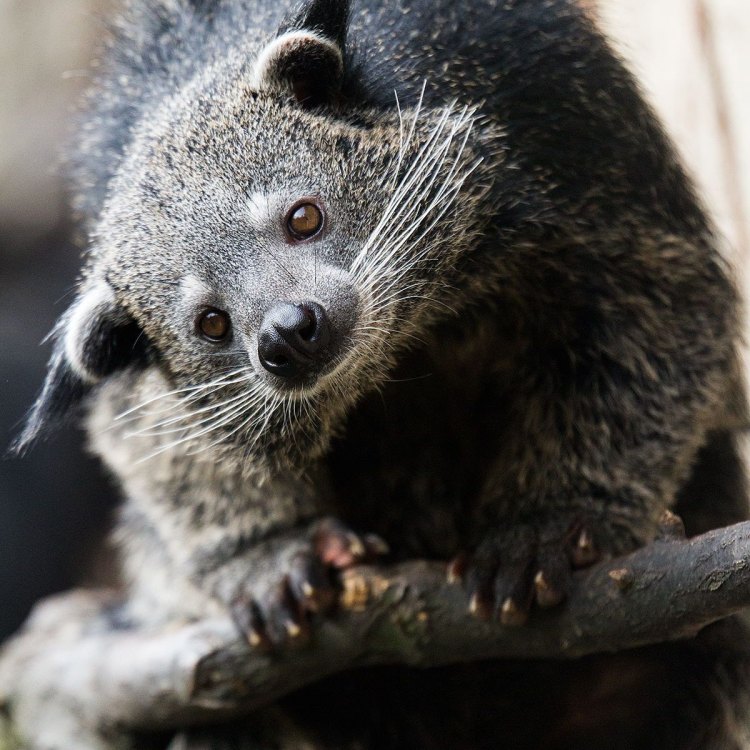
Binturong: The Tree-Loving Bearcat of Southeast Asia
Disclaimer: The content provided is for informational purposes only. We cannot guarantee the accuracy of the information on this page 100%. All information provided here may change without prior notice.

